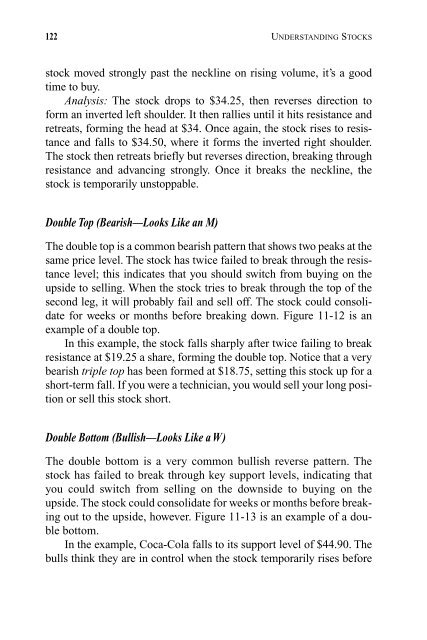Understanding Stocks
Understanding Stocks
Understanding Stocks
Create successful ePaper yourself
Turn your PDF publications into a flip-book with our unique Google optimized e-Paper software.
122 UNDERSTANDING STOCKS<br />
stock moved strongly past the neckline on rising volume, it’s a good<br />
time to buy.<br />
Analysis: The stock drops to $34.25, then reverses direction to<br />
form an inverted left shoulder. It then rallies until it hits resistance and<br />
retreats, forming the head at $34. Once again, the stock rises to resistance<br />
and falls to $34.50, where it forms the inverted right shoulder.<br />
The stock then retreats briefly but reverses direction, breaking through<br />
resistance and advancing strongly. Once it breaks the neckline, the<br />
stock is temporarily unstoppable.<br />
Double Top (Bearish—Looks Like an M)<br />
The double top is a common bearish pattern that shows two peaks at the<br />
same price level. The stock has twice failed to break through the resistance<br />
level; this indicates that you should switch from buying on the<br />
upside to selling. When the stock tries to break through the top of the<br />
second leg, it will probably fail and sell off. The stock could consolidate<br />
for weeks or months before breaking down. Figure 11-12 is an<br />
example of a double top.<br />
In this example, the stock falls sharply after twice failing to break<br />
resistance at $19.25 a share, forming the double top. Notice that a very<br />
bearish triple top has been formed at $18.75, setting this stock up for a<br />
short-term fall. If you were a technician, you would sell your long position<br />
or sell this stock short.<br />
Double Bottom (Bullish—Looks Like a W)<br />
The double bottom is a very common bullish reverse pattern. The<br />
stock has failed to break through key support levels, indicating that<br />
you could switch from selling on the downside to buying on the<br />
upside. The stock could consolidate for weeks or months before breaking<br />
out to the upside, however. Figure 11-13 is an example of a double<br />
bottom.<br />
In the example, Coca-Cola falls to its support level of $44.90. The<br />
bulls think they are in control when the stock temporarily rises before

















